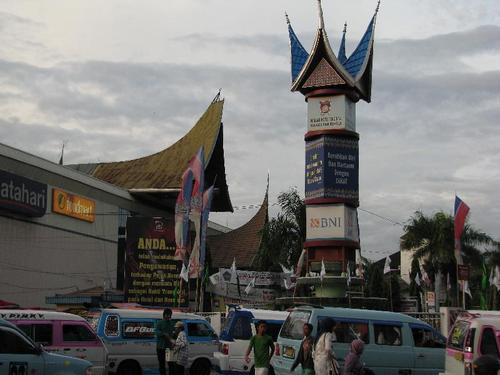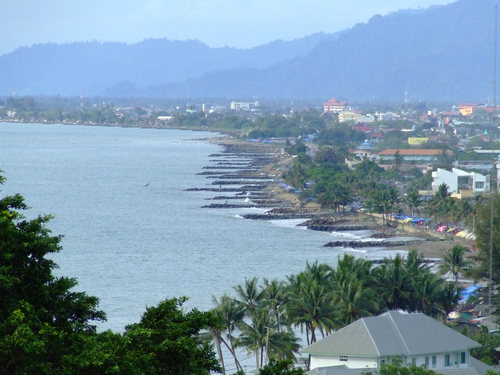Padang, Indonesia
From Wikipedia, the free encyclopedia
Jump to: navigation, search
Padang
Padang Beach
Seal
Motto: Padang Kota Tercinta(Indonesian: Padang, the beloved City)
Padang
Location of Padang in Indonesia
Coordinates: 0°57′0″S 100°21′11″E / -0.95, 100.35306
Country
Indonesia
Province
West Sumatra
Government
- Mayor
Fauzi Bahar
Area
- Total
694.96 km² (268.3 sq mi)
Elevation
3 m (10 ft)
Population (2000)
- Total
757,600
- Density
1,090/km² (2,823.1/sq mi)
Time zone
WIB (UTC+7)
Area code(s)
+62 751
Website: www.padang.go.id
Padang (means field) is the capital and largest city of West Sumatra, Indonesia. It is located on the western coast of Sumatra at 0°57′0″S 100°21′11″E / -0.95, 100.35306. It has an area of 694.96 square kilometres (268.3 sq mi) and a population of over 750,000 people.
Contents[hide]
1 History
2 Administration
3 Transport
4 Education
5 Culture
5.1 Cuisine
5.2 Sport
6 Tourism
7 References
8 External links
//
[edit] History
Padang circa 1795
Since the 16th century Padang has been a trade centre. During the 16th and 17th centuries pepper was cultivated and traded with India, Portugal, the United Kingdom and the Netherlands. In 1663 the city came under the authority of the Dutch. The Dutch built a trading post here in 1680. The city came under British authority twice, the first time from 1781 to 1784 during the Fourth Anglo-Dutch War, and again from 1795 to 1819 during the Napoleonic Wars. Afterwards the city was transferred back to the Netherlands. Up to approximately 1780 the most important trade product was gold, originating from the gold mines in the region. When the mines where exhausted, the emphasis turned to other products such as coffee, salts and textiles.
In 1797 Padang was inundated by a tsunami with an estimated flow depth of 5–10 meters, following an earthquake, estimated to be 8.5–8.7 Mw, which occurred off the coast. The shaking caused considerable damage and the deaths of two people, while the tsunami resulted in several houses being washed away and several deaths at the village of Air Manis. The boats moored in the Arau river ended up on dry land, including a 200 ton sailing ship which was deposited about 1 kilometer upstream. In 1833 another tsunami inundated Padang with an estimated flow depth of 3–4 meters as a result of an earthquake, estimated to be 8.6–8.9 Mw, which occurred off Bengkulu. The shaking caused considerable damage in Padang, and due to the tsunami the boats moored in the Arau river broke their anchors and were scattered.[1]
At the time of independence the city had 50,000 or so inhabitants. Coffee was still important, but copra was also a major item produced by farmers in its hinterland. The population growth since then has been partly a result of growth in the area of the city, but largely is a result of the migration to major cities seen in so many developing nations. In 1950 there had also been a development of the Ombilin coal field with Padang as its outlet. This is an indication of the colonization of Indonesia having been economic as well as political.
[edit] Administration
Street in central Padang
Padang is divided in 11 subdistricts (kecamatan): Bungus Teluk Kabung, Koto Tangah, Kuranji, Lubuk Begalung, Lubuk Kilangan, Nanggalo, Padang Barat, Padang Selatan, Padang Timur, Padang Utara, Pauh
[edit] Transport
The city is served by the newly-opened Minangkabau International Airport in Ketaping, Padang Pariaman. Padang's Teluk Bayur harbor is the largest and busiest harbor on the west coast of Sumatra.
[edit] Education
Andalas University, Limau Manis campus
Andalas University is the oldest university in Indonesia outside of Java. The main campus is located at Limau Manis, about 12 kilometres (7 mi) from the center of Padang. The other universities in Padang are Universitas Negeri Padang in Air Tawar, Bung Hatta University in Ulak Karang, Baiturrahmah University in Air Pacah, Universitas Putra Indonesia YPTK, Ekasakti University, Universitas Muhammadiyah Sumatera Barat and Tamansiswa University.
[edit] Culture
[edit] Cuisine
The cuisine of the Minangkabau people is commonly called Padang cuisine, due to it being the capital and largest city of the region. Padang restaurants are common throughout the country and are famous for their spicy food and their unique way of serving it. Padang food is usually cooked once per day, and all customers choose from those dishes, which are left out on display until no food is left. It is served in small portions of various dishes, but constituting, with rice, a complete meal. In a Padang-style restaurant, the table will quickly be set with dozens of small dishes filled with highly-flavored foods such as curried fish, fried tempeh, stewed greens, chili eggplant, curried beef liver, fried chicken, and of course, sambals, the spicy sauces ubiquitous at Indonesian tables. Customers take - and pay for - only what they want from this array of dishes. Food safety is generally a concern, as many customers take food out of communal dishes with their hands, dishes which will be served to subsequent customers. The best known Padang dish is rendang, a spicy meat stew. Soto Padang (crispy beef in spicy soup) is local residents' breakfast favorite, meanwhile Sate (beef satay in curry sauce served with ketupat) is a treat in the evening.
[edit] Sport
Padang is the home town of the soccer team Semen Padang, with Haji Agus Salim Stadium being the home stadium of the club.
Padang is home to an annual international dragon boat competition. [2]
[edit] Tourism
Padang is a common transit point for surfers traveling to Batu Islands and Mentawai Islands, and for tourists visiting the West Sumatran highlands. Padang beach (known as Taplau or Tapi Lauik) which located from Samudra Street until Puruih, is well-known for its beautiful sunset and hundreds of food stalls. Bungus bay, to the south of Padang, is suitable for swimming and boating.
Adityawarman Museum specializes in the history and culture of the local Minangkabau ethic group, and the main exhibits are housed within a Rumah Gadang style building.
Panorama of Padang circa 1900
[edit] References
^ Natawidjaja, D. H.; K. Sieh, M. Chlieh, J. Galetzka, B. W. Suwargadi, H. Cheng, R. L. Edwards, J.-P. Avouac, and S. N. Ward (June 2006). "Source parameters of the great Sumatran megathrust earthquakes of 1797 and 1833 inferred from coral microatolls". Journal Of Geophysical Research 111 (B06403): B06403. doi:10.1029/2005JB004025.
^ http://www.dragon-boats.com/dbnet/dragon_boat_races_international.htm
[edit] External links
Indonesia portal
(Indonesian) Official website
Padang travel guide from Wikitravel
[hide]
v • d • eRegencies and cities of West Sumatra
Regencies
Agam Dharmasraya Limapuluh Koto Mentawai Islands Padang Pariaman Pasaman West Pasaman South Pesisir Sijunjung Tanah Datar Solok South Solok
Cities
Bukittinggi Padang Padang Panjang Pariaman Payakumbuh Sawahlunto Solok
Retrieved from "http://en.wikipedia.org/wiki/Padang,_Indonesia"
Categories: Regencies of West Sumatra Cities, towns and villages in West Sumatra
Senin, 15 Desember 2008
Langganan:
Postingan (Atom)





